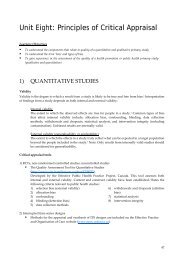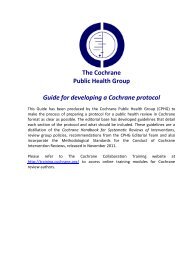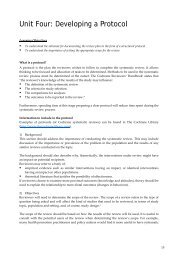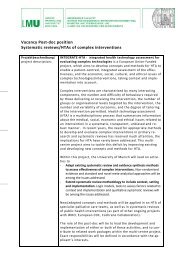Train the Trainer Course book - Cochrane Public Health Group
Train the Trainer Course book - Cochrane Public Health Group
Train the Trainer Course book - Cochrane Public Health Group
You also want an ePaper? Increase the reach of your titles
YUMPU automatically turns print PDFs into web optimized ePapers that Google loves.
population on gender, age, or education level. As such, <strong>the</strong> authors concluded that <strong>the</strong> study had<br />
strong generalisability to <strong>the</strong> greater target population (Elder et al., 2000).<br />
Example: All <strong>the</strong> participating schools were state primary schools sited outside <strong>the</strong> inner city area.<br />
Socio-demographic measures suggested that <strong>the</strong> schools’ populations generally reflected <strong>the</strong> Leeds<br />
school aged population, although <strong>the</strong>re was a slight bias towards more advantaged children. The<br />
schools had 1-42% children from ethnic minorities and 7-29% entitled to free school meals compared<br />
with 11% and 25% respectively for Leeds children as a whole.<br />
2) Allocation bias<br />
Bias can result from <strong>the</strong> way that <strong>the</strong> intervention and control groups are assembled. 3 Unless groups<br />
are equivalent or balanced at baseline, differences in outcomes cannot confidently be attributed to <strong>the</strong><br />
effects of <strong>the</strong> intervention. 4 Studies which show that comparison groups are not equivalent at baseline<br />
have high allocation bias.<br />
Random allocation is <strong>the</strong> best method to produce comparison groups that are balanced at baseline for<br />
known and unknown confounding factors, and <strong>the</strong>refore reduce allocation bias. This is usually<br />
achieved by toin-cossing or developing computer-generated random number tables. This ensures that<br />
every participant in <strong>the</strong> study has an equal chance (50%/50%) of being in <strong>the</strong> intervention or control<br />
group.<br />
Ideally, <strong>the</strong> coin-tossing or computer-generated randomisation should be carried out by individuals<br />
external to <strong>the</strong> study. Once <strong>the</strong> allocation scheme is developed, <strong>the</strong> allocation of participants to<br />
intervention and control group should be carried out by someone who is not responsible for <strong>the</strong><br />
study to prevent manipulation by researchers and participants. Therefore, once <strong>the</strong> allocation scheme<br />
has been developed it is important that allocation to intervention and control group is concealed.<br />
Concealment of allocation is <strong>the</strong> process to prevent foreknowledge of group assignment. 1 Methods to<br />
conceal allocation include allocation by persons external to <strong>the</strong> study and sequentially numbered,<br />
sealed opaque envelopes. Unfortunately, information on concealment of allocation is very rarely<br />
reported in primary studies.<br />
Example: Worksites were randomised within blocks: unionised versus non-unionised; single versus<br />
multiple buildings; and three worksites that were part of a single large company. Worksites were<br />
randomly assigned by <strong>the</strong> study biostatistician using a process conducted independently from <strong>the</strong><br />
intervention team.<br />
Example: Subjects were randomised to one of three arms: (1) Direct Advice, (2) Brief Negotiation or<br />
(3) Control by household with each monthly batch forming a single permuted block. Randomisation<br />
of intervention arms were sent to CF (<strong>the</strong> investigator) in sealed opaque envelopes. At <strong>the</strong> health<br />
check participants were asked to consent to a randomised trial of <strong>the</strong> effect of health professionals’<br />
communication style on patient’s health behaviour, namely physical activity. If consent was given,<br />
<strong>the</strong> envelope was opened and <strong>the</strong> appropriate intervention carried out.<br />
There are also quasi-randomised methods of allocating participants into intervention and control<br />
groups. These include alternation (eg. first person intervention, second person control), allocation by<br />
date of birth, day of week, etc. These methods are not able to conceal allocation, do not guarantee that<br />
every participant has an equal chance of being in ei<strong>the</strong>r comparison group, and consequentially do<br />
not guarantee that groups will be similar at baseline.<br />
70








